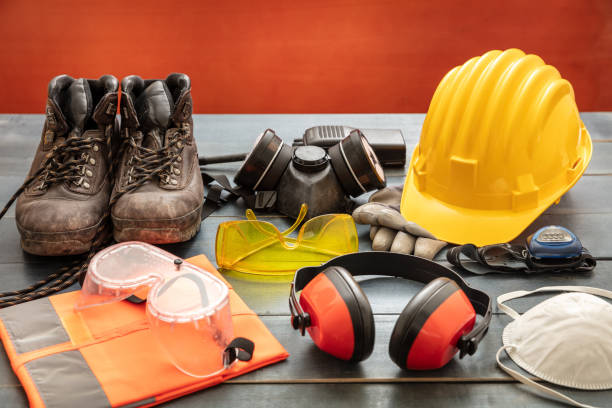Construction workwear is an essential component of ensuring safety, productivity, and comfort on construction sites. From heavy-duty jackets and reinforced pants to high-visibility vests and protective footwear, construction workwear serves multiple purposes that go beyond simply providing clothing. This article will delve into the importance of construction workwear, the types of gear available, and the key factors to consider when selecting the right apparel for a construction site.
The Importance of Construction Workwear
Construction workwear is not just about looking professional—it’s about safety, durability, and comfort in an environment that poses various physical risks. Workers on construction sites are exposed to potential hazards such as falling objects, electrical hazards, slippery surfaces, and extreme weather conditions. Proper workwear helps minimize these risks and ensures that workers can perform their tasks safely and effectively.
The primary roles of construction workwear include:
- Safety: Protecting workers from physical harm is the top priority. Protective gear can help prevent injuries from heavy machinery, falling debris, or other construction-related dangers.
- Visibility: High-visibility clothing helps workers be seen, particularly in low-light conditions, reducing the risk of accidents with vehicles or machinery.
- Comfort and Mobility: Construction workers often work long hours in challenging conditions, so workwear must offer comfort, breathability, and flexibility to ensure that they can move freely and stay comfortable throughout the day.
- Durability: Construction environments are tough on clothing. High-quality materials that are tear-resistant, water-resistant, and able to withstand harsh conditions are essential for long-lasting wear.
Key Types of Construction Workwear
Construction workwear encompasses a wide range of clothing and protective gear, each designed to address specific hazards and environmental conditions on the job site. Some of the most common types of construction workwear include:
- High-Visibility Clothing: These garments are made from bright-colored fabrics like neon yellow or orange and are often equipped with reflective stripes to enhance visibility. High-visibility vests, jackets, and shirts are critical for workers who are near heavy equipment, traffic, or low-light areas.
- Protective Footwear: Boots are arguably one of the most critical pieces of construction workwear. Safety boots are designed with reinforced toes (steel, composite, or aluminum) to protect against falling objects, punctures, and compression injuries. They also offer slip-resistant soles, waterproofing, and ankle support to keep workers safe in various conditions.
- PPE (Personal Protective Equipment): This includes items such as hard hats, gloves, goggles, ear protection, and knee pads. Hard hats provide head protection from falling objects or head bumps, while gloves protect the hands from abrasions, cuts, and chemical exposure. Goggles or face shields protect the eyes from debris, dust, and hazardous materials, while ear protection helps reduce the risk of hearing damage from loud machinery.
- Work Shirts and Jackets: Work shirts and jackets are often made from durable, breathable fabrics such as cotton or polyester blends. They provide protection from the elements while allowing for adequate ventilation to keep workers cool. Jackets, in particular, are useful for cold weather, offering insulation and weatherproofing without compromising mobility.
Factors to Consider When Choosing Construction Workwear
Selecting the right construction workwear involves a balance between safety, comfort, durability, and functionality. Here are some factors to keep in mind:
- Safety Standards: Workwear should meet specific industry standards, such as those set by OSHA (Occupational Safety and Health Administration) or ANSI (American National Standards Institute). These standards ensure that workwear provides the necessary protection in terms of visibility, resistance to hazards, and durability.
- Comfort and Fit: Comfort is crucial, as workers may wear construction workwear for long hours. Clothes should allow for easy movement, especially for tasks that require bending, lifting, or kneeling. Look for gear with adjustable features such as waistbands, cuffs, and straps to ensure a good fit.
- Climate and Environment: The climate and working conditions should influence the selection of workwear. For example, in hot climates, lightweight, moisture-wicking fabrics are essential to keep workers cool. In colder environments, insulated jackets, thermals, and layered clothing will help retain body heat.
- Durability and Material: Construction workwear must withstand tough conditions, so it should be made of durable fabrics such as heavy-duty denim, canvas, or ripstop material. The gear should also be resistant to wear and tear from physical activities, abrasion, and exposure to the elements.
Conclusion
Construction workwear is more than just a uniform; it is a vital part of ensuring the safety, comfort, and productivity of workers on construction sites. Proper workwear helps mitigate the risks associated with construction work while providing the comfort and durability needed to perform tasks efficiently. When selecting workwear, it is essential to prioritize safety standards, fit, material durability, and climate suitability to create an optimal work environment for everyone involved. Whether you are working in extreme weather conditions, handling heavy machinery, or simply need to be visible in high-traffic areas, investing in high-quality construction workwear is an investment in safety and efficiency.
Visit amplivibes.com for more.


Welcome and thank you for posting, nice article.
Submit an article instant live and fast indexed here